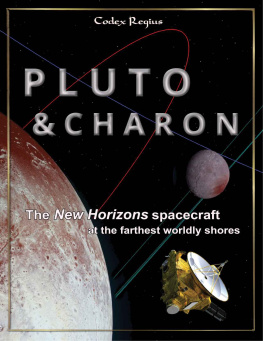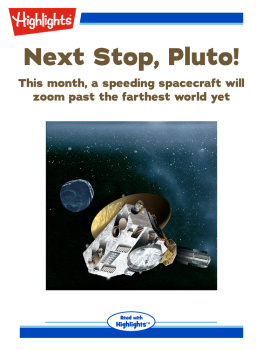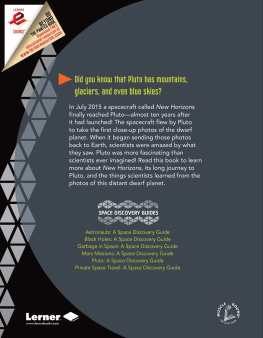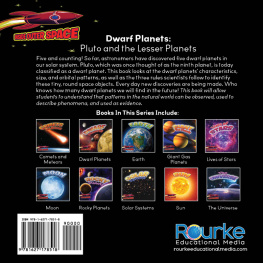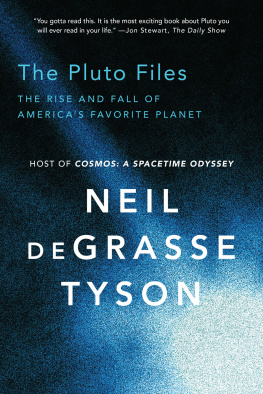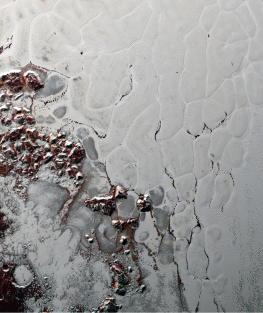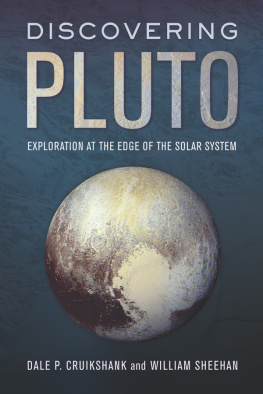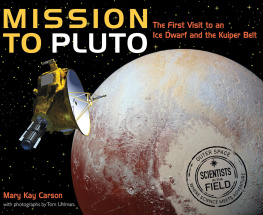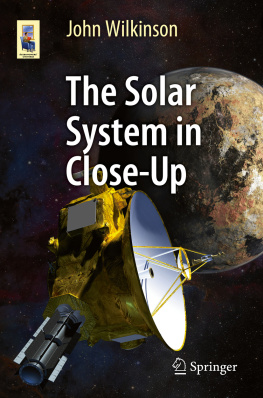Codex Regius
Pluto & Charon
The New Horizons spacecraft at the farthest worldly shores
Non-fiction
st edition 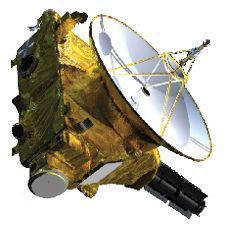
Other books from this series:
- Titan - Plutos big brother (1 st ed. December 2016)
- Ceres - Plutos little sister (1 st ed. June 2017)
- Enceladus - Iceland of Space (1 st ed. January 2018)
Published by: 2016 Codex Regius
Printed by CreateSpace
Also available for Kindle and other ebook devices.
All rights reserved.
Authors: Codex Regius
Website: https://www.codex-regius.eu
Contact: info@codex-regius.eu
Andreas Mhn/Metka Klemeni, Mhlborngasse 1,
D-65199 Wiesbaden
Layout: Codex Regius
Image credits, unless otherwise noticed: NASA/JHUAPL/SwRI
This book is protected by copyright and may not reproduced entirely or in parts without express permission of the authors.
In this book its two authors have managed to present the intriguing results of New Horizons Pluto flyby in a mode that non-professionals will understand, without waiving appropriate scientific accuracy.
Pluto was discovered by Clyde Tombaugh in 1930 and stayed the only known large object in the outer solar system for more than 60 years. Then, since the 1990s, improved CCD technology helped track down more than a thousand other objects in the Kuiper Belt. The size of some of them came close to Pluto, and Eris, photographed in 2003 but escaping notice till 2005, threatened even to replace it as the biggest object in the Kuiper Belt. The result was a re-definition of the term planet by the general assembly of the International Astronomical Union, held in Prague in summer 2006. Pluto is no longer called a planet since. From the perspective of celestial mechanics, this decision may be reasonable and logical because Pluto does something that a decent planet should not do: It crosses the orbit of another planet. The large planet Neptune has forced small Pluto and several hundred, recently discovered, smaller bodies called plutinos into a 3:2 orbital resonance by its gravitational force that avoids any collisions with Neptune.
Fortunately, half a year had already passed since the launch of the New Horizons spacecraft when the new definition of the term planet was voted about. If Pluto had not been a planet at that time any more, some overzealous US-senators might have simply cancelled its construction to add the money saved to their military budget. (This was what had indeed happened to the Dawn spacecraft for some months.) In such a case, the wonderful close-ups of this amazing world at the very edge of the solar system would have escaped us.
With the findings of New Horizons in mind, said new definition should be reconsidered. I am sure that the voting would have had a different result if we had already known back then what New Horizons has revealed to us about Pluto. The new definition is based on celestial mechanics only and does not take Plutos peculiarities into account that it has from the planetologists point of view. It has more characteristics of a regular planet than the twice as large inner planet Mercury: While Mercury is a grey orb whose surface has primarily been shaped by impacts, New Horizons has shown us Pluto as a body with a distinctive geology of its own from far away already. There are diverse types of terrain present: mountainous areas alternate with smooth plains of nitrogen glaciers in which water icebergs are drifting about, driven to the edges of convection cells by up-welling heat; their dark summits peak out like islands.
Unlike airless Mercury, Pluto does have an atmosphere that does not simply become more tenuous from inside out, but it is many-layered in the very meaning of the word: images of Plutos rim reveal several banks of haze at different levels above ground. There must be some kind of weather as well. As Pluto heads on to those parts of its orbit that are remote from the sun, a part of its atmosphere will freeze out and precipitate on its surface, only to thaw again when it is back to perihelion - 200 years later. And one of the images, scientists believe, even seems to depict a cloud bank.
Moreover, Pluto has a complex satellite system comprised of five moons, and their periods resonate with each other and they are almost exact multiples of the revolutional period of the biggest moon, Charon. Compare this to the fact that Mercury and Venus have no moons at all, our Earth, one, Mars, two small ones, and among the minor planets there are only systems with up to two moons known.
Even though Pluto may not be elevated to planet status again, our solar system and the eight planets that are officially left will presumably not represent the complete image yet. During the last few years, six lesser bodies have been discovered far away whose perihelions (their points of closest approach to the sun) are located far beyond Neptune and the Kuiper Belt. And their orbits are close together in space, which may perhaps not be explained by chance alone. These objects measure less than 1,000 km in diameter, and therefore, they are certainly not proper planets. But they cannot have developed out there, in empty space. Something larger must have taken them so far out from the sun, like Neptune has set the plutinos and other objects of the Kuiper Belt on their courses.
Mike Brown, he who has initiated Plutos demolition by discovering almost Pluto-sized Eris, supposes that a planet may be lurking out there that has about 10 times the mass of the Earth. Such a behemoth would certainly fit the new criteria for proper planets, and Mike Brown has already assigned the unofficial name Planet Nine to it. Based on the data of those six farthest bodies, an approximate orbit of this still hypothetical planet can be also computed. According to these values, it travels around the sun 700 times as far out as Earth and 30 times as far out as Neptune, spending about 20,000 years on one revolution. But at which point of its orbit it might be at the moment, that cannot be computed.
That this planet has not been discovered yet should not struck anyone by surprise. Since the brightness of a body decreases by the fourth power of its distance from the sun, even an object as large as Neptune would be a million times dimmer than that. Mike Brown is rather confident, however, that his Planet Nine will be detected within the next 5 to 10 years by improved sky survey programmes. Once it has been located, a spacecraft will certainly be sent to this planet, and the two authors behind the Codex Regius label are no doubt already standing ready to publish the results of this flyby in a book. If NASA should take recent plans of a laser-powered interstellar miniature probe serious, this might even happen within our lifetime.
We have waited long enough for the Pluto flyby.
But it has been worth waiting, that you will see on the following pages!
Dr Rainer Riemann
Heidelberg, in June 2016
Primary events of nine and a half years of spaceflight
2006 - 19 January Launch
28 January Course correction
30 January Course correction
09 March Course correction
07 April Crossed the orbit of Mars
11-13 June New Horizons observes planetoid 2002 JF56 (lated named APL)
21 September First images of Pluto (using LORRI)
2007 - 28 February Passing Jupiter/gravity assist
27 June New Horizons first hibernation begins
25 September Course correction
September-November Annual Checkout Operation (ACO) 1
2008 - 08 June Crossed the orbit of Saturn
July-August Annual Checkout Operation (ACO) 2
2009 - July-August Annual Checkout Operation (ACO) 3

